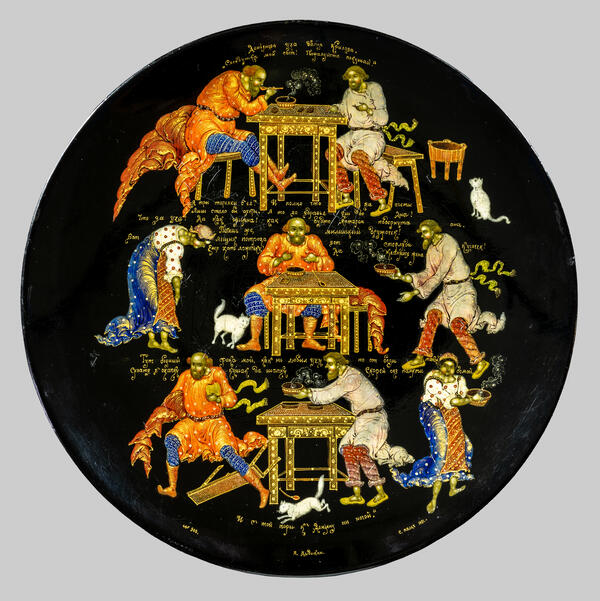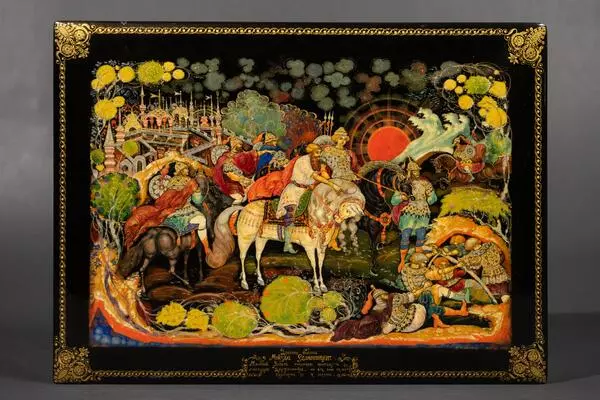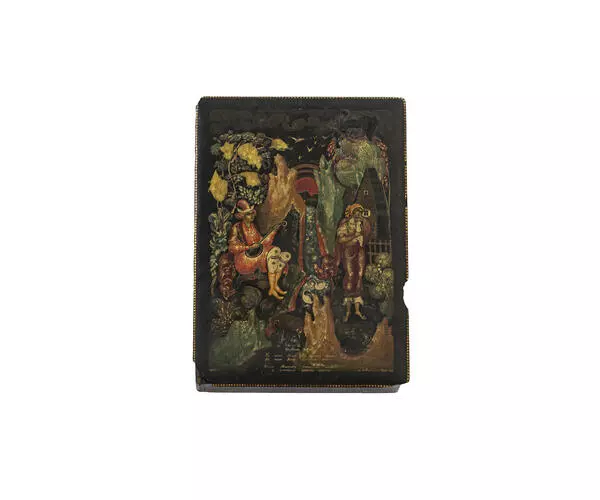Aristarkh Dydykin’s works are rightfully considered the most distinctive among the Palekh artists. He started making lacquer miniatures in 1926, but did not find his style hight away. The artist had to face many failures, and his talent was recognized only after some time.
The decorative plate ‘DemyAn’s Fish Soup’ was created in 1931. The composition is based on a fable of the same name by Ivan Krylov. It is a humorous story that tells about one neighbor treating the other to ukha (Russian fish soup), but offering him so much that the guest has to simply run away.
The artist used just the right amount of decorative elements. The clear and simple composition is enclosed in a circle. Three scenes, depicted one under the other, accurately convey the plot of Krylov’s fable. In the top scene, the guest named Foka is sitting at a small table, eating hot fish soup with great pleasure. The owner of the house, Demyan, is sitting on a bench opposite him.
In the second scene, Foka has set the bowl and spoon aside, showing that he is full. A white cat is rubbing its face on his shoes, the house owner’s wife is bowing to the guest… But on the right, Demyan is bringing him another bowl of soup. The artist placed the text from the fable above the drawing:
“I”ve had three bowls. That”s quite enough.
Eat as much as your heart desires! It”s good for your health!
Just look at this hearty soup! It looks like liquid amber.
Eat some, dear friend! ”
In the last scene, Foka hastily escapes such hospitality. He has knocked over the bench, and his spoon has fallen under the table. The guest is running away, his hat in his hands, his belt flapping behind him. Above the scene there is an inscription in gold. It says that, no matter how much poor Foka loved fish soup, he had to grab his things and run away from “such trouble”. The closing line of the fable frames the image in an arc: “And since then, he has never been seen at Demyan”s.”
Aristarkh Dydykin’s style is easily recognizable. The artist preferred lush, ornate forms. He drew inspiration from the Art Nouveau style, which became popular in the early 20th century. It was distinguished by almost theatrical colorfulness and love for flowing lines reminiscent of floral ornaments.
To make the painting brighter, the artist added some contrasting colors to the first layers of paint. He then painted over the layers with soot—black pigment. The artist always used gold abundantly, but did not let it overshadow the other colors. This approach deprived the works of Aristarkh Dydykin of subtlety, but gave the artistic images unprecedented power and emotional expressiveness. The miniature contains the images invented by the artist himself, for example, the white cat. The animal makes the image look livelier and more emotional, and therefore more reliable.
The decorative plate ‘DemyAn’s Fish Soup’ was created in 1931. The composition is based on a fable of the same name by Ivan Krylov. It is a humorous story that tells about one neighbor treating the other to ukha (Russian fish soup), but offering him so much that the guest has to simply run away.
The artist used just the right amount of decorative elements. The clear and simple composition is enclosed in a circle. Three scenes, depicted one under the other, accurately convey the plot of Krylov’s fable. In the top scene, the guest named Foka is sitting at a small table, eating hot fish soup with great pleasure. The owner of the house, Demyan, is sitting on a bench opposite him.
In the second scene, Foka has set the bowl and spoon aside, showing that he is full. A white cat is rubbing its face on his shoes, the house owner’s wife is bowing to the guest… But on the right, Demyan is bringing him another bowl of soup. The artist placed the text from the fable above the drawing:
“I”ve had three bowls. That”s quite enough.
Eat as much as your heart desires! It”s good for your health!
Just look at this hearty soup! It looks like liquid amber.
Eat some, dear friend! ”
In the last scene, Foka hastily escapes such hospitality. He has knocked over the bench, and his spoon has fallen under the table. The guest is running away, his hat in his hands, his belt flapping behind him. Above the scene there is an inscription in gold. It says that, no matter how much poor Foka loved fish soup, he had to grab his things and run away from “such trouble”. The closing line of the fable frames the image in an arc: “And since then, he has never been seen at Demyan”s.”
Aristarkh Dydykin’s style is easily recognizable. The artist preferred lush, ornate forms. He drew inspiration from the Art Nouveau style, which became popular in the early 20th century. It was distinguished by almost theatrical colorfulness and love for flowing lines reminiscent of floral ornaments.
To make the painting brighter, the artist added some contrasting colors to the first layers of paint. He then painted over the layers with soot—black pigment. The artist always used gold abundantly, but did not let it overshadow the other colors. This approach deprived the works of Aristarkh Dydykin of subtlety, but gave the artistic images unprecedented power and emotional expressiveness. The miniature contains the images invented by the artist himself, for example, the white cat. The animal makes the image look livelier and more emotional, and therefore more reliable.






